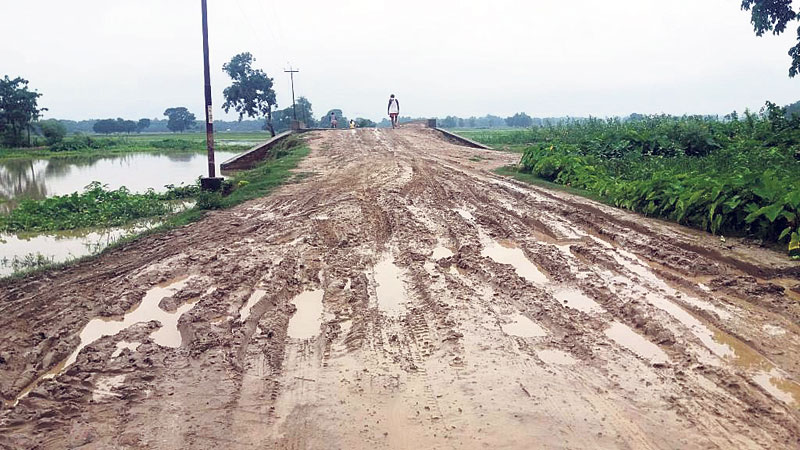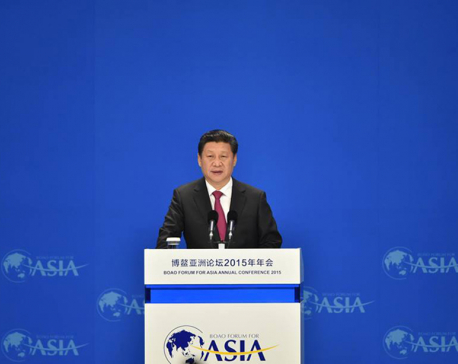
OR

Huge sums have been invested, year after year, but there has still been no economic growth. This is not only surprising but startling
During his campaign speeches, US President Donald Trump made an issue of the “tremendous” waste of government money on fighting foreign wars. This money, he argued, could have been more usefully spent at home. Trump puts the cost of wars in the Middle East at US $6 trillion which is enough, he said, to rebuild vital US infrastructure—roads, bridges, railways, tunnels, electric grids, airports, water supply and sanitation network—three times over. This means that mere US $2 trillion would be enough to fund an upgrade of US infrastructure from “third-world grade” to advanced country standards.
Now let us discuss these figures in Nepal’s context. Of course, Nepal’s is a miniscule economy compared to the US. But still the matter can be put into perspective. We can scale down the US economy to one-tenth of one percent to make it commensurate with the size of Nepal’s economy. What this means is that Trump’s $2 trillion infrastructure spending for the US is equivalent to $2 billion for Nepal, which, in my reckoning, would be enough to rebuild and upgrade its vital infrastructures to world-class standards.
But where will that money come from? For a better understanding of the options, let us look at the recent budget numbers.
Nepal’s capital budget, which actually is spending earmarked for infrastructure projects, has averaged over $1 billion a year since 2008/09, which totals to upward of $10 billion over a nine-year period through 2016/17. Of course, actual spending has been less than the budget allocation, with 76.2 percent actually spent in 2015/16. We can then assume that 75 percent of funds allocated for capital budget was actually spent on capital projects—a total of $7.5 billion over this nine-year period.
Applying Trump’s reasoning that $6 trillion would be three times what is needed to rebuild US infrastructure, we can then say that $7.5 billion of capital spending in Nepal could have re-built its infrastructure three times over or, in the worst case scenario, could have built all roads and highways, bridges and tunnels, electric grid and transmission lines, airports and communication networks, water supply and sanitation lines, at least for one time.
However, there is practically nothing on the ground to match the spending of $7.5 billion on infrastructure projects. The projects in existence may not be worth more than 10 percent of the total spending, or less than $1 billion. What happened to the rest of the money—over $6 billion since 2008? It must have ended up in the pockets of those assigned to manage infrastructure projects: project managers, contractors and engineers.
But, according to current practices, half of this amount must have gone to political leaders and their apparatchiks who, working at the highest levels of government, exercise ultimate authority to skim-off project money.
We can guess the abuses of infrastructure money from macroeconomic indicators, the way such spending relates to investment and growth. Government investment has been low in terms of the size of the economy—about 5 percent of GDP—but total investment including from private sector has been upward of 25 percent of GDP over the past decade and between 15 to 20 percent of GDP over many earlier decades.
Because investment spending is taken as the main driver of economic growth, this level of national investment sustained over long periods should produce, at the low end, 4 to 5 percent growth which, indeed, is reported in the official data. However, much of this growth is imaginary, an outcome of faulty and misleading government data series that are churned out year after year without proper surveys, monitoring and assessment of work actually done on the ground.
One cue to the actual state of the national economy would be to look at the per capita income over long periods as reported by the World Bank and other international agencies. Averaging per capita income data from these sources, Nepal’s per capita income was $690 in 2015, increasing from just $100 in late 1960s, as estimated by IMF/World Bank. This would then suggest a seven times larger per capita income now as compared to late 1960s.
However, it would be misleading to read this as an indicator of real growth because one needs to adjust current dollar per capita income for inflation in US prices. This inflation increased by eight times over the same period, which is larger than the increase in current dollar per capita income. We can then conclude that economic growth has barely kept up with population growth despite massive amounts invested to help the economy grow. For example, IMF reports that total investment averaged 30 percent of GDP over the past five years. In terms of dollars, investment spending totaled $25 billion over this period, with government’s own investment worth $5 billion.
Now such huge sums invested in the economy, year after year, with almost no growth is not only surprising but startling. One can’t deny that overall economy did grow somewhat but all of it was offset by population growth. A further implication of this is that if economic growth just matched population growth, the economic growth was the result of population or labor force growth and not related to other factors that contribute to growth—factors like capital, technology, natural resources and entrepreneurship. This mismatch between the economy’s growth rate and in growth inducing factors is special to Nepal, since no other country with established and reliable data base has recorded such a zero-growth outcome, especially when investment is as high as 30 percent of GDP.
This finding then builds a compelling case for investigating the efficiency with which growth resources are getting used, especially the usage of investment capital, of which about half is financed from foreign aid and the other half from local tax and borrowing. Moreover, loan funding of investment has built up $7.5 billion in foreign debt and about a similar amount of debt to domestic lenders. The sad part of all these revelations is that there is little to show in terms of improvements in the country’s economic well-being, as indicated by an unchanged per capita income in real terms over the past half century.
So what happened to all the money that was spent chasing economic growth and prosperity? The answer is that there has been a massive abuse of growth resources, including investment money. Government data asserting a different outcome are then all wrong or cooked up.
There is no shortage of stories of corrupt politicians and bureaucrats pocketing a lion’s share of development funds but there has as yet been no major investigation of these corruption cases. However, the growth and investment data that are available clearly suggest a massive misuse of development funds that, if they were spent wisely and honestly, could easily double the country’s economy every ten years and turn Nepal into a mid-income country in just four decades.
sshah1983@hotmail.com
You May Like This

China says economy got a strong start in 2024, sets sights on latest technology, upgrading factories
BEIJING (AP) — China has plenty of room to maneuver to attain its annual target for robust economic growth of... Read More...

China's Xi promises to lower tariffs this year, open economy further
BOAO, April 10: Chinese President Xi Jinping on Tuesday promised to open the country’s economy further and lower import tariffs... Read More...

Blockade institutionalized ‘black economy’: Experts
KATHMANDU, June 20: Experts said Monday that the five month long blockade not only fueled the black economy and corruption but... Read More...





Just In
- MoHP cautions docs working in govt hospitals not to work in private ones
- Over 400,000 tourists visited Mustang by road last year
- 19 hydropower projects to be showcased at investment summit
- Global oil and gold prices surge as Israel retaliates against Iran
- Sajha Yatayat cancels CEO appointment process for lack of candidates
- Govt padlocks Nepal Scouts’ property illegally occupied by NC lawmaker Deepak Khadka
- FWEAN meets with President Paudel to solicit support for women entrepreneurship
- Koshi provincial assembly passes resolution motion calling for special session by majority votes







_20220508065243.jpg)






Leave A Comment